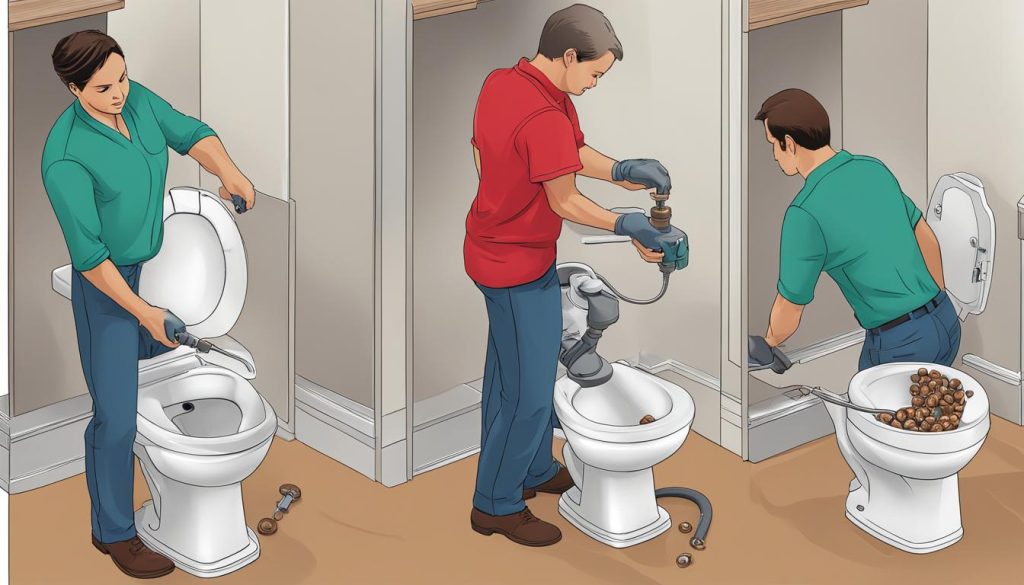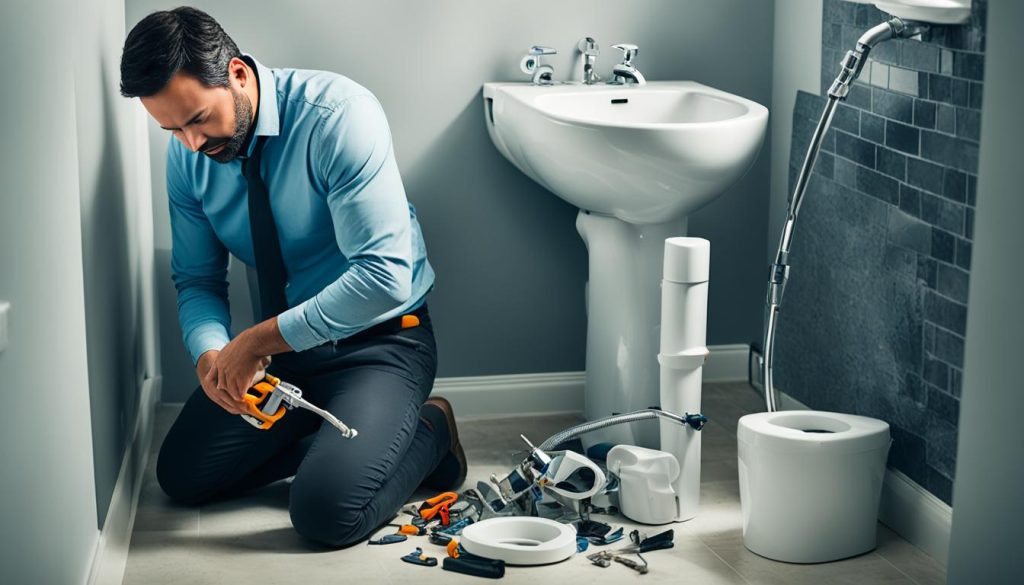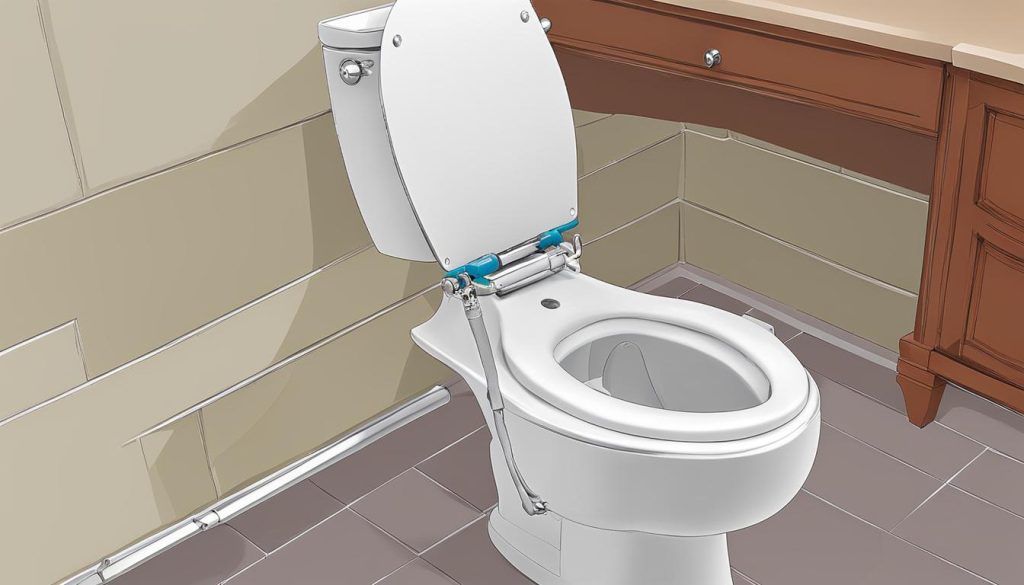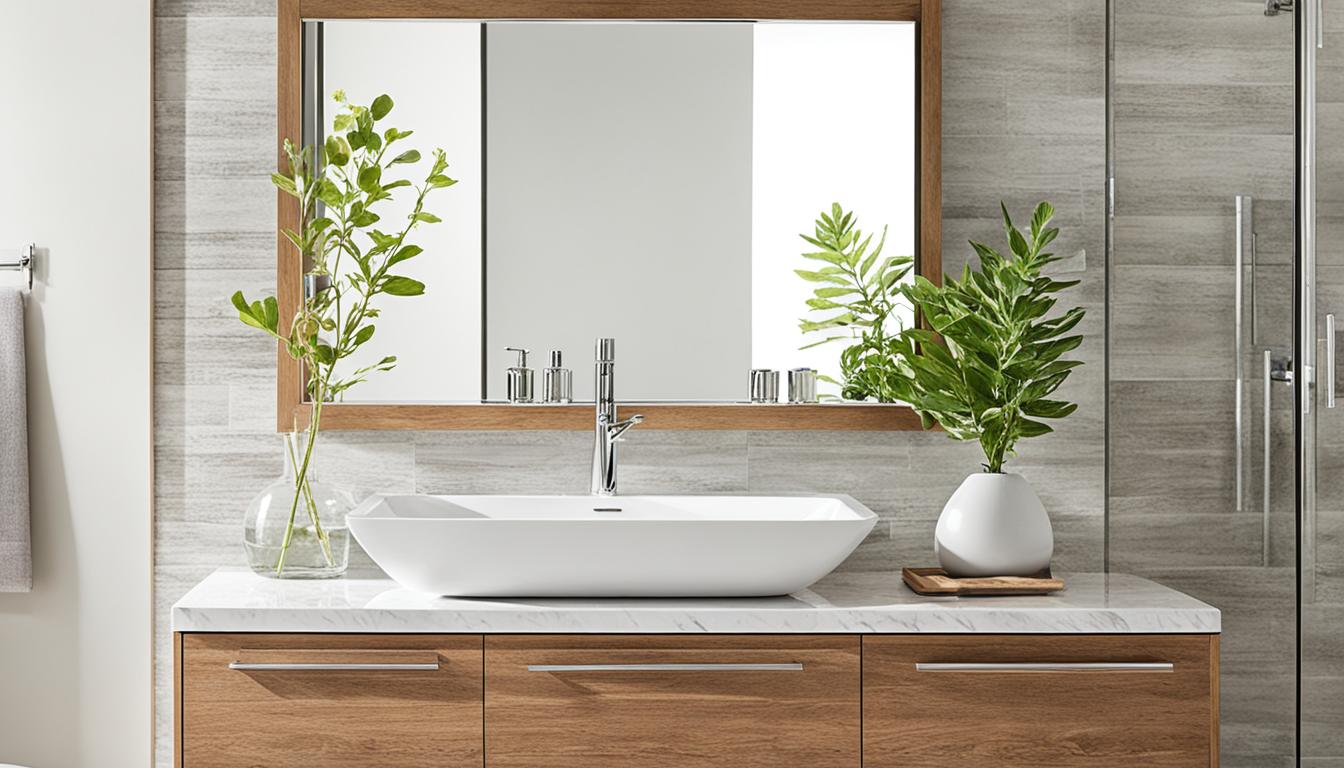cleanyourbutt.com and its partners may earn a commission if you purchase a product through one of our links
Removing a bidet seat doesn’t require professional experience, but some plumbing tools are essential. In this guide, we will provide you with a step-by-step bidet removal process, so you can easily uninstall your bidet without any hassle.
Key Takeaways:
- Gather the necessary tools such as an adjustable wrench, Teflon tape, and a screwdriver.
- Shut off the main water supply and disconnect the electric outlet and drain the pipe if you have an electric bidet.
- Flush the water tank to empty it.
- Remove the water hose and the “T” valve from the toilet tank.
- Unscrew the bolts and mounting plate to remove the existing bidet seat.
Tools and Materials Needed for Bidet Removal
When it comes to bidet removal, having the right tools and materials is crucial. This ensures a smooth and efficient process, allowing you to uninstall the bidet fixture with ease. Here are the essential tools and materials you’ll need:
- An adjustable wrench
- Teflon tape
- A screwdriver
- Pliers
If your bidet is connected to the water supply with pipes, a pipe wrench may also be necessary. Additionally, it’s important to have a bucket or towel handy to catch any water that may spill during the removal process. Plumbers tape is essential for creating a watertight seal when reinstalling the bidet or connecting any pipes.
After successfully removing the bidet, it’s essential to clean the area thoroughly. Having cleaning supplies such as disinfectant spray and a cloth will help you ensure that the surrounding area is left clean and hygienic.
In summary, the tools and materials needed for bidet removal include an adjustable wrench, Teflon tape, a screwdriver, pliers, a pipe wrench (if applicable), a bucket or towel to catch any water, plumbers tape for creating a watertight seal, and cleaning supplies for post-removal cleanliness. With these essential items on hand, you’ll be well-prepared to tackle the bidet removal process with confidence and efficiency.
| Tools | Materials |
|---|---|
| Adjustable wrench | Teflon tape |
| Screwdriver | Bucket or towel |
| Pliers | Plumbers tape |
| Pipe wrench (if applicable) | Cleaning supplies |
Step-by-Step Guide to Removing a Bidet
To remove a bidet, follow these step-by-step instructions:
-
Gather the necessary tools: Before starting the bidet removal process, make sure you have the following tools on hand:
- Adjustable wrench
- Teflon tape
- Screwdriver
- Pliers
- Turn off the water supply and disconnect the tubing: Locate the water shut-off valve near the toilet and turn it off. Then, disconnect the tubing that connects the bidet to the water supply.
- Flush the bidet to drain any remaining water: Press the flush button on the bidet control panel to drain the water from the bidet.
- Unscrew the bolts that secure the bidet seat to the toilet bowl and lift off the seat: Use a screwdriver or wrench to unscrew the bolts that hold the bidet seat in place. Once the bolts are removed, gently lift off the bidet seat.
- Remove the bolts or screws that attach the bidet to the toilet: Use a screwdriver or wrench to remove the bolts or screws that secure the bidet to the toilet. Set aside the hardware for future use or disposal.
- Disconnect any additional attachments such as a handheld sprayer or control panel: If your bidet has any additional attachments, such as a handheld sprayer or control panel, carefully disconnect them from the main unit.
- Clean the area thoroughly and inspect for any damage or leaks: Use a mild detergent and water to clean the toilet bowl and surrounding area. Inspect the toilet and plumbing connections for any signs of damage or leaks.
- Install a toilet cap if you are not replacing the bidet immediately: If you do not plan to install a new bidet right away, cover the exposed toilet attachment point with a toilet cap to prevent debris from entering the pipes.
Removing a bidet can be a straightforward process if you follow these step-by-step instructions. By gathering the necessary tools, disconnecting the water supply, removing the bidet seat and attachments, and thoroughly cleaning the area, you can successfully complete the bidet removal process. Whether you are replacing the bidet or removing it permanently, it’s important to follow these steps carefully to ensure a smooth and efficient uninstallation.

Benefits of Removing a Bidet
If you’re considering removing a bidet from your bathroom, there are several benefits you should be aware of:
- Space-saving: Removing a bidet can free up valuable space in your bathroom, making it especially beneficial for smaller bathrooms where space is limited.
- Cost reduction: Bidets require maintenance and repairs over time, which can add up to significant costs. By removing a bidet, you can eliminate the need for these expenses and reduce your overall maintenance costs.
- Cost savings: Bidets can be a significant investment, both in terms of the initial purchase and ongoing expenses such as electricity and water usage. By removing a bidet, you can save money in the long run.
- Customization: Removing a bidet allows you to customize your bathroom according to your personal preferences and aesthetics. You can choose alternative fixtures or accessories that better suit your needs and style.
By considering these benefits, you can make an informed decision about whether removing a bidet is the right choice for your bathroom.
Customer Testimonial:
“I removed the bidet from my bathroom and it was a game-changer. I gained so much space and saved a significant amount of money on maintenance and repairs. Plus, I was able to create a bathroom that truly reflects my style. Highly recommend it!”
– Sarah Johnson, Happy Bidet Remover
If you’re still on the fence about bidet removal, continue reading for a closer look at the potential disadvantages and factors to consider before making a decision.
Disadvantages of Removing a Bidet
Although there are benefits to removing a bidet, it’s important to consider the potential disadvantages before making a decision. One of the main drawbacks is the loss of cleanliness and hygiene that bidets provide. Bidets offer a thorough cleanse and are known for their superior level of hygiene compared to using toilet paper alone.
For individuals who prefer the familiar sensation of using toilet paper, removing a bidet may not be suitable. Some people find comfort and convenience in using toilet paper, and removing the bidet could disrupt their preferred routine.
Another consideration is that some individuals have specific health conditions that require the use of a bidet for proper hygiene. Bidets can provide relief and assistance to those with certain medical needs, making it important to carefully weigh the decision to remove a bidet.
It’s crucial to evaluate the advantages and disadvantages of bidet removal to ensure it aligns with your personal needs, preferences, and health requirements.

What to Consider Before Removing a Bidet
Before embarking on the bidet removal process, it is essential to take into account several factors that will help you make an informed decision. First and foremost, it’s crucial to understand the underlying reason for removing the bidet. Is it due to space constraints in your bathroom, personal preference, maintenance issues, or the need for a bathroom remodel?
By identifying the specific motivation behind bidet removal, you can better assess whether it aligns with your needs and goals. For example, if space is a primary concern, removing the bidet can create more room and improve the overall functionality of your bathroom. On the other hand, if you appreciate the convenience and benefits of a bidet, such as improved hygiene, it may be worth exploring alternative solutions like a bidet seat attachment.
Another crucial aspect to consider is the potential impact on hygiene and cleanliness. Bidets are well-known for their ability to provide thorough cleansing, which can enhance personal hygiene. When removing a bidet, the alternative cleaning methods, such as toilet paper, may not offer the same level of cleanliness.
Cost savings and customization options should also be taken into account. Removing a bidet can potentially lead to long-term cost savings, as bidets often require maintenance and in some cases, repairs. Moreover, without a bidet, you have the freedom to customize your bathroom according to your preferences and aesthetic vision.
If you have any concerns or uncertainties about the bidet removal process, it can be helpful to consult with professionals. They can offer expert advice and guidance, ensuring that the removal is done safely and efficiently. Additionally, professionals can provide valuable insights and alternative options that you may not have considered.

Realizing the Benefits of Bidet Removal
While bidets offer numerous advantages, it’s essential to carefully weigh the pros and cons when considering their removal. By taking these factors into account, you can make an informed decision that best suits your individual needs and preferences, ensuring a bathroom that meets your requirements and reflects your personal style.
Professional Help for Bidet Removal
While bidet removal can be done as a DIY project, there may be instances where professional help is needed. This could be especially true if you are unfamiliar with plumbing or if there are complex issues involved. Professional plumbers have the experience and knowledge to tackle bidet removal efficiently and effectively. By hiring a professional, you can ensure that the bidet is removed properly and that any potential risks or complications are minimized. If you are unsure about any aspect of the bidet removal process, do not hesitate to seek professional assistance.
Conclusion
Removing a bidet can be a relatively straightforward process if you have the right tools and follow the necessary steps. By following our bidet removal guide, you can confidently undertake the bidet removal process yourself or seek professional assistance if needed.
When considering bidet removal, it’s important to weigh the benefits against the potential disadvantages. Bidet removal can free up valuable space in your bathroom and reduce maintenance and repair costs. Moreover, it allows for customization of your bathroom according to your personal preferences. However, it’s crucial to take into account the potential loss of hygiene benefits that bidets provide, especially if you have specific health conditions or preferences.
Whether you decide to remove the bidet on your own or hire a professional, it’s essential to carefully consider your reasons for bidet removal and the impact it may have on your lifestyle. Remember, bidet removal can be a practical solution to create a more personalized bathroom experience.
FAQ
How do I uninstall a bidet?
To uninstall a bidet, gather the necessary tools, including an adjustable wrench, Teflon tape, and a screwdriver. Shut off the main water supply, disconnect the electric outlet (if applicable), and drain the pipe. Flush the water tank, remove the water hose and “T” valve from the toilet tank, and unscrew the bolts and mounting plate to remove the bidet seat.
What tools and materials do I need to remove a bidet?
The tools needed to remove a bidet include an adjustable wrench, Teflon tape, a screwdriver, pliers, and a pipe wrench (if applicable). You may also need a bucket or towel to catch water, plumbers tape for creating a watertight seal, and cleaning supplies to clean the area after removal.
What are the step-by-step instructions for removing a bidet?
The step-by-step process for removing a bidet includes turning off the water supply, disconnecting the tubing, flushing the bidet, unscrewing the bolts securing the bidet seat, removing the bolts or screws attaching the bidet to the toilet, disconnecting additional attachments, cleaning the area, and optionally installing a toilet cap.
What are the benefits of removing a bidet?
Removing a bidet can free up space in a bathroom, reduce maintenance and repair costs, lead to cost savings, and allow for customization of the bathroom according to personal preference and aesthetics.
What are the disadvantages of removing a bidet?
Removing a bidet can result in the loss of cleanliness and hygiene benefits that bidets provide. It may not be suitable for individuals who prefer using toilet paper or who have specific health conditions that require a bidet.
What should I consider before removing a bidet?
Before removing a bidet, consider the reason for removal, potential impact on hygiene and cleanliness, cost savings, customization options, and consult with professionals if needed.
When should I seek professional help for bidet removal?
If you are unfamiliar with plumbing or if there are complex issues involved, it is advisable to seek professional help for bidet removal. Professional plumbers have the experience and knowledge to ensure proper removal and minimize risks or complications.
Where can I find a bidet removal guide?
You can find bidet removal guides and step-by-step instructions online or from reputable plumbing resources. It’s important to follow a reliable guide and ensure you have the necessary tools and knowledge before attempting bidet removal.


